Light
Light is a form of energy that can be detected by our eyes.
OR
Light is a form of energy that produces the sensation of sight of view.
Properties of light
- A beam of light travels in a straight path.
- Light is an electromagnetic wave.
- The speed of light is 300000 kilometres per second.
- In a vacuum, light travels at approximately 3×108 m/s or 300000 kilometres per second.
Note: The relationship between speed of light, wavelength, and frequency is given by c = λ f
Luminous Object
The objects which emit its light are called luminous objects.
example- Sun, Stars, Bulb etc.
Non-luminous Object
An object that does not emit its light is called a non-luminous object.
example- Moon, Pen, Human etc.
Reflection of Light
Coming back of light to the same medium, when light falls on a surface is called reflection of light.
Laws of Reflection
There are two laws of reflection of light.
First Law: The angle of incidence is equal to the angle of reflection. i.e. ∠i=∠r
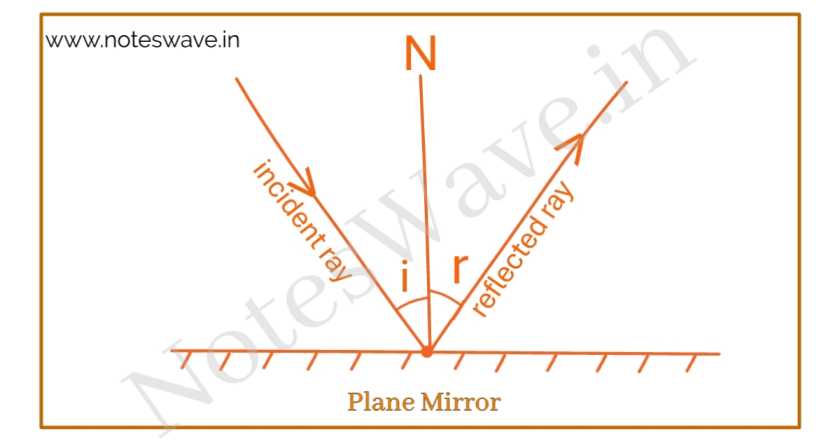
Second Law: The incidence ray, the normal to the mirror at the point of incidence and the reflected ray, all lie in the same plane.
Note: Any ray of light that is incident normally on a mirror is reflected back along the same path.
Question. When a ray of light is incident normally, the angle of incidence is ?
(a) 90 degree
(b) 45 degree
(c) 0 degree
(d) none
Answer: (c) 0 degree
Convergent Rays
Convergent rays are the light rays that meet at a single point.
Divergent Rays
Divergent rays are the light rays that spread out from a single point.
Object
The point of intersection of the incident ray is called the object.
Real Object: The object is said to be real if incident ray emit from it.
Virtual Object: The point at which incident ray of light appear to meet is known as virtual object.
Image
The point of intersection of the reflected ray is called the image.
Real Image: The point at which reflected/refracted rays of light meet is known as real image.
or
If the light rays coming from a point actually meet after reflection, then the image formed is called a real image.
Virtual Image: The point at which reflected/refracted rays of light appear to meet is known as virtual image.
or
If light rays are coming from a point, after reflection/refraction do not meet actually but appear to meet at another point then the image formed is called a virtual image.
Some Important Points Regarding Real & Virtual Images
- Real images formed on same side as object in case of mirror but on opposite side in case of lens.
- Virtual images formed on opposite side as object in case of mirror but on same side as object in case of lens.
- Real images obtained on a screen & virtual images cannot be obtained on a screen.
Image Formation by Plane Mirror
Properties of Image In A Plane Mirror
- The size of the image is equal to the object.
- The image is always virtual.
- Object and image are equidistant from the plane mirror.
- If the object is real then the image will be virtual and vice-versa.
Uses of plane mirror: Looking glass, Periscope etc.
Question. A ray of light is incident on a plane mirror at an angle of incidence of 15°. The deviation in the ray produced by the mirror is: [2024]
(A) 30°
(B) 60°
(C) 120°
(D) 150°
Spherical Mirror
A mirror whose reflecting surface is curved inwards or outwards is called a spherical mirror.
Spherical mirrors are of two types
1. Concave Mirror: A spherical mirror whose reflecting surface is curved inward is called a concave mirror.
2. Convex Mirror: A spherical mirror whose reflecting surface is curved outward is called a convex mirror.
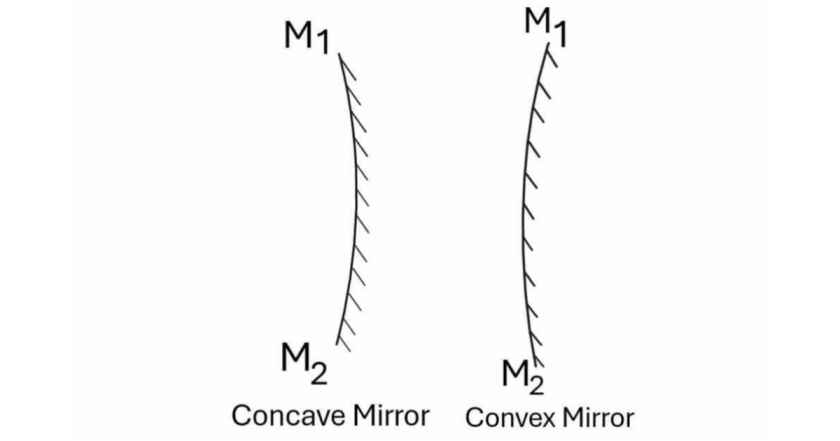
Some Important Terms Related to Spherical Mirrors
The Center of Curvature: It is the point in the center of the mirror which passes through the curve of the mirror and has the same tangent and curvature at that point. It is denoted by the letter ‘C‘.
Radius of Curvature (R)
It is the linear distance between the Pole and the Center of Curvature.
Pole (P)
It is the midpoint of the spherical mirror.
Focus (F)
It is any given point, where light rays parallel to the principal axis, will converge after getting reflected from the mirror.
Focal Length
The distance between the pole and the principal focus of a spherical mirror is called the focal length and It is represented as ‘f‘.
Aperture
The diameter of the reflecting surface of a spherical mirror is called aperture.
Relation between R and Focal Length F F=\frac{R}{2}
Rules For Making Ray Diagrams By Spherical Mirror
Rule 1: If the incident ray is parallel to the principal axis, then the reflected ray passes through the principal focus in case of concave mirror or appear to diverge from the principal focus in case of convex mirror.

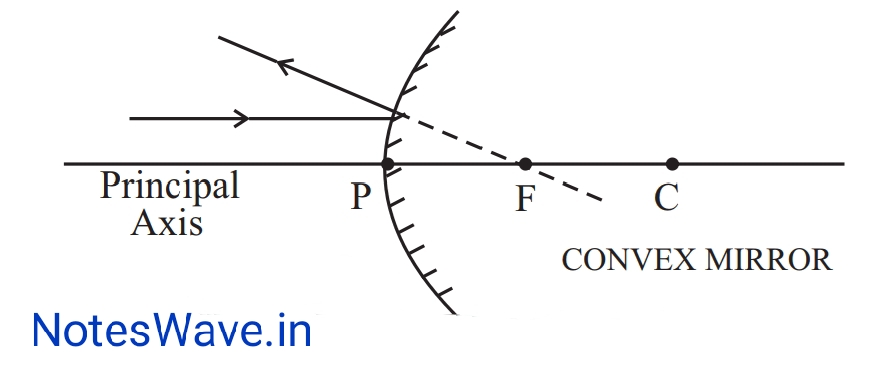
Rule 2: If the incident ray passes through the principal focus of a concave mirror or the incident ray is directed towards the principal focus of a convex mirror then the reflected rays emerge parallel to the principal axis.
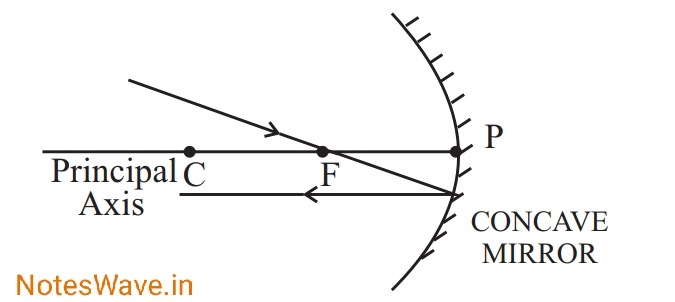
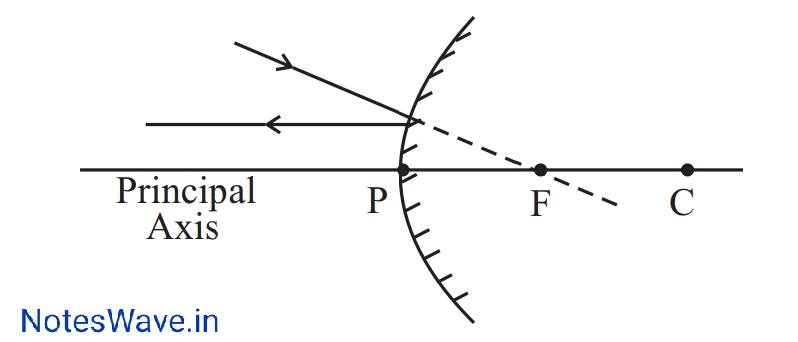
Rule 3: If the incident ray passes through the centre of curvature of concave mirror or directed in the direction of centre of curvature of a convex mirror, then the reflected ray is back along the same path.
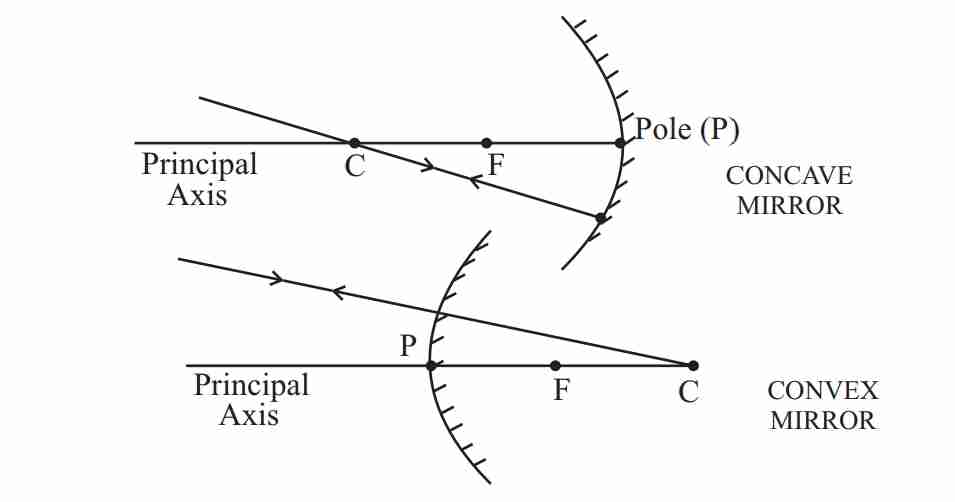
Rule 4: If the ray incident on the pole of the spherical mirror then incident ray and reflected ray make equal angles with the principal axis.
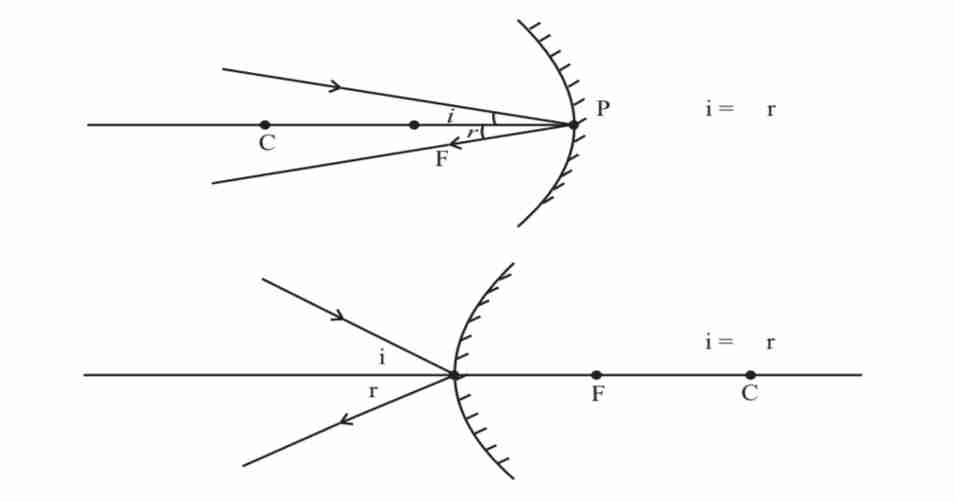
Image Formation by Concave Mirror
Ray Diagrams for Images Formed by Concave Mirror
1. Object at Infinity
If an object is placed at infinity in front of a concave mirror, its image is formed at the principal focus, real, inverted and much smaller than the object.
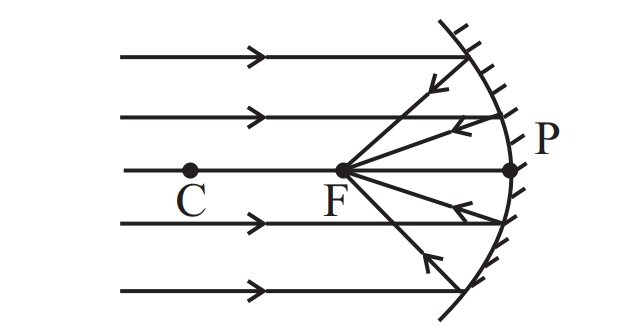
2. Object beyond the Centre Of Curvature
If an object is placed beyond the centre of curvature in front of a concave mirror, its image is formed between F and C, real, inverted and smaller than the object.
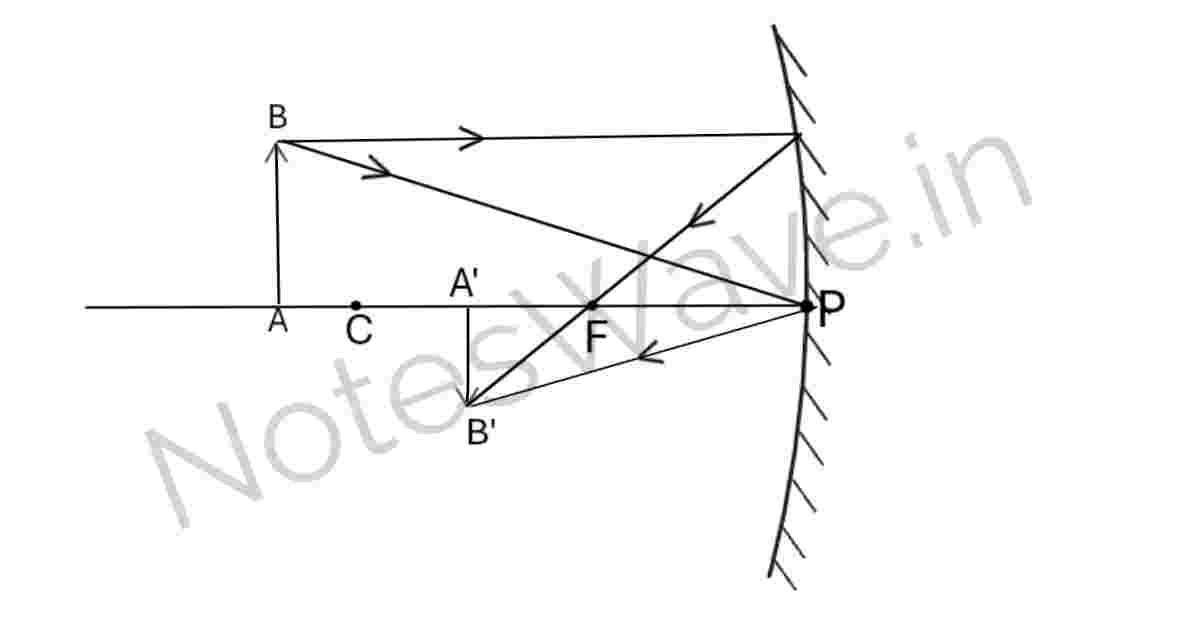
3. Object at the Centre Of Curvature
If an object is placed at C (centre of curvature) in front of a concave mirror, its image is formed at C (centre of curvature), real, inverted and same size.
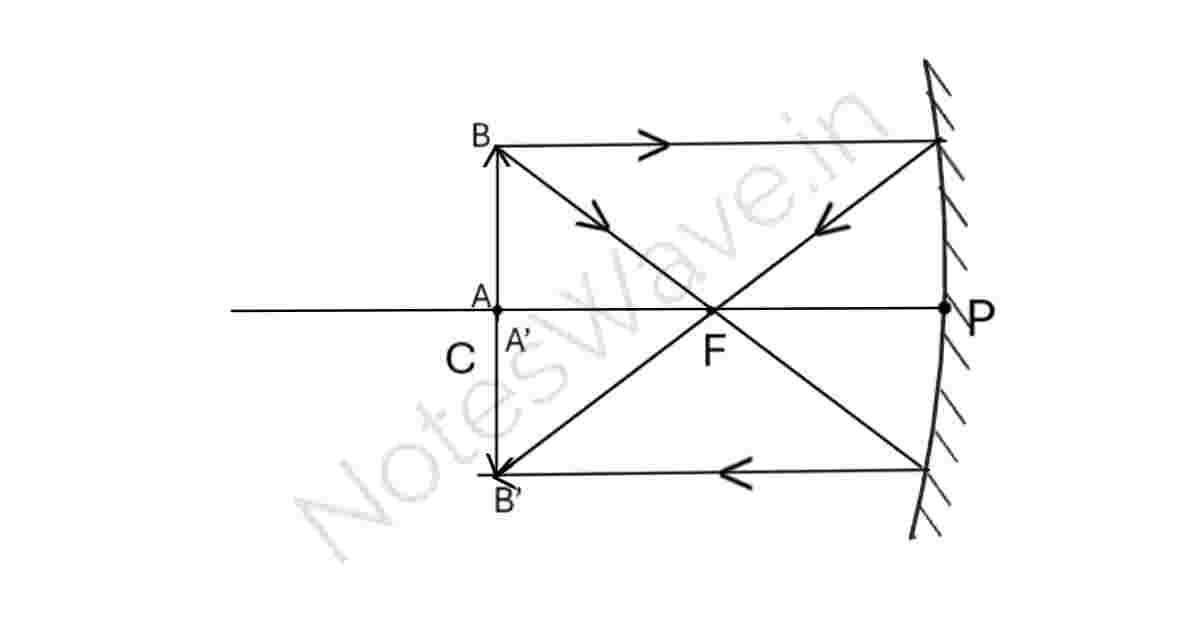
4. Object between the Centre of Curvature and Focus
If an object is placed between F and C in front of a concave mirror, its image is formed beyond C, real, inverted and enlarged.
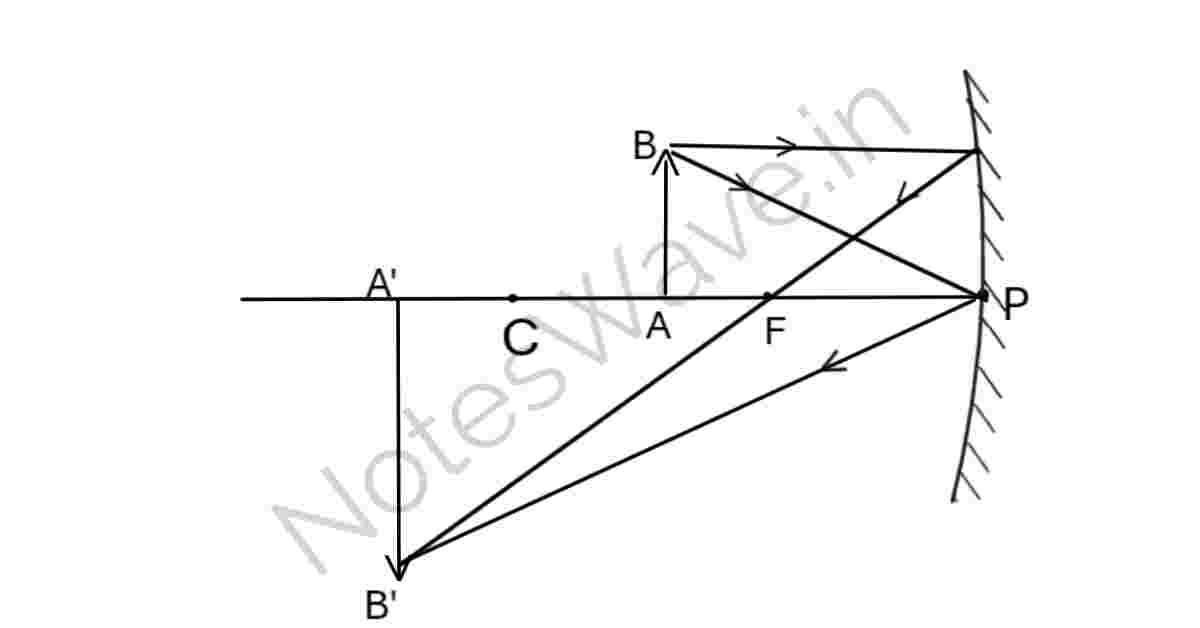
5. Object at the Focus
If an object is placed at F (focus) in front of a concave mirror, its image is formed at infinity, real, inverted and highly enlarged.
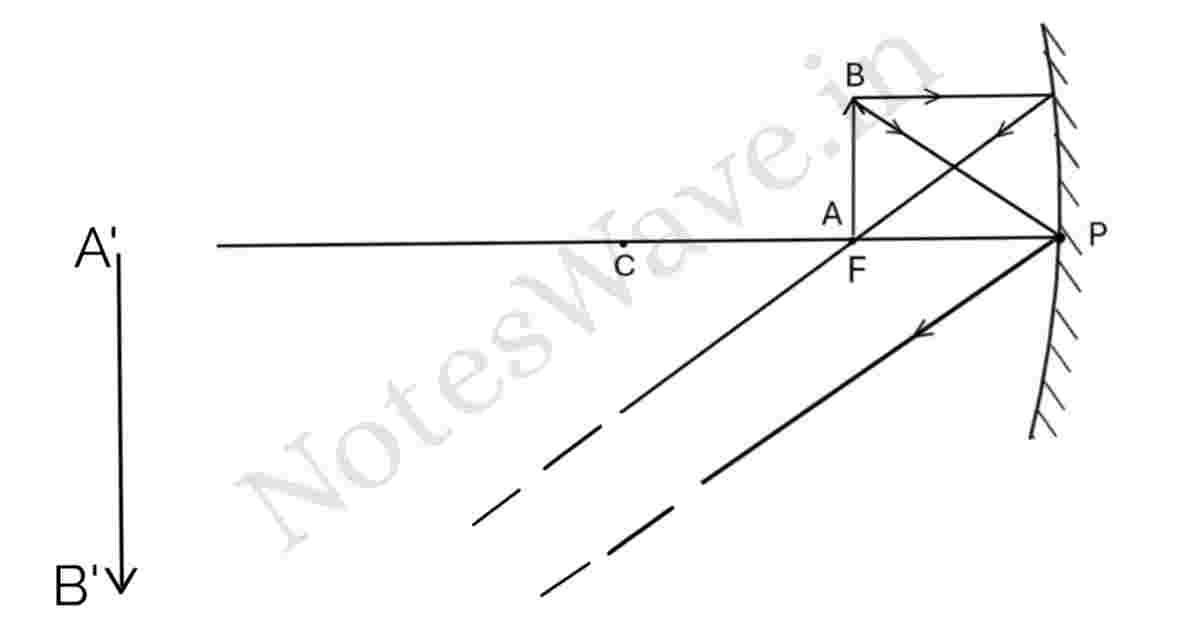
6. When an object is placed between ‘F’ and ‘P’
If an object is placed between ‘F’ and ‘P’ in front of a concave mirror, its image is formed behind the mirror, virtual, erect and enlarged.

Uses of Concave Mirror
- Concave mirrors are used by dentists to see large images of the teeth of patients. ( Teeth should be placed between pole and focus).
- Concave mirrors are used in torches, Searchlights and vehicle headlights to get powerful parallel beams of light.
- Concave mirrors are used as saving mirrors to see a larger image of the face.
- Concave mirrors are used to concentrate sunlight to produce heat in a solar furnace.
Question. In torches,search lights and head lights of vehicles the bulb is placed
(a) Between pole and focus
(b) Very near to the focus
(c) Between focus and centre of curvature
(d) At centre of curvature
Ans. (b) Very near to the focus
Image Formation by Convex Mirror
Ray Diagrams of Images Formation by Convex Mirror
Here we consider only two positions of the object firstly when the object is at infinity and the second position, when the object is at a finite distance from the mirror.
1. Object at infinity
If an object is placed at infinity in front of a convex mirror, its image is formed behind the mirror at the principal focus which is virtual, erect and much smaller than the object.
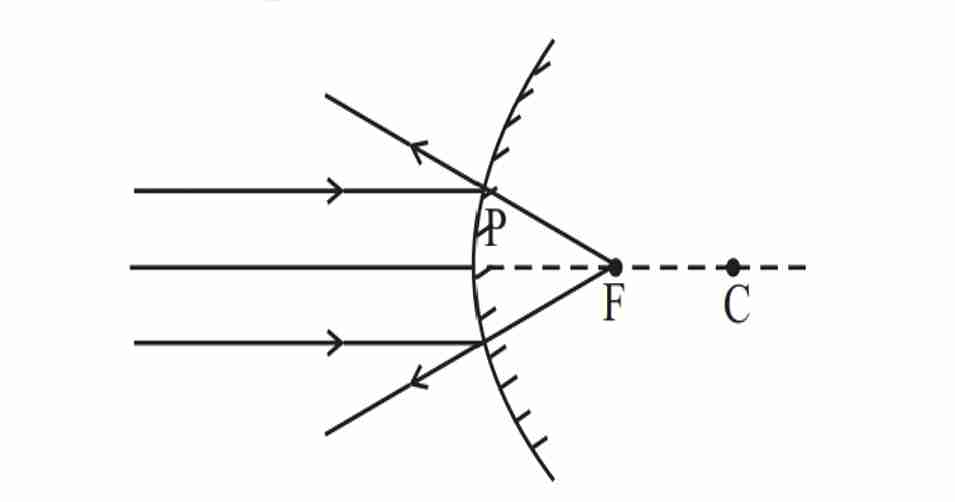
2. When the object is placed anywhere between the pole and infinity
If an object is placed between the pole and infinity in front of a convex mirror, its image is formed behind the mirror between the pole and focus which is virtual, erect and smaller (point-sized) than the object.
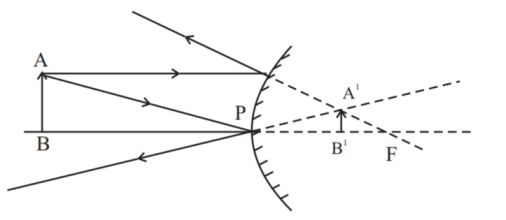
Uses of Convex Mirror
- Convex mirrors are used as rear-view mirrors in vehicles.
- Convex mirrors are used at blind turns and on points of merging traffic to facilitate vision of both sides of traffic.
- Convex mirrors are used in shops as security mirrors.
Sign Convention for Reflection by Spherical Mirror
- The object is placed to the left of the mirror.
- All distances parallel to the principal axis are measured from the pole of the mirror.
- All distances major in the direction of the incident ray (along + X-axis) are taken as positive and those measured against the direction of the incident ray (along – X-axis) are taken as negative.
- The distance measured perpendicular to and above the principal axis is taken as positive.
- The distance measured perpendicular to and below the principal axis is taken as negative.
Mirror Formula
\frac{1}{f}=\frac{1}{v}+\frac{1}{u}
where,
f = focal length
v = image distance
u = object distance
Magnification
Magnification gives the relative extent to which the image of an object is magnified with respect to object size.
m=−\frac{v}{u}
or
m=\frac{h_{i}}{h_{o}}
Click here 👉 Important Numericals
Exercise Questions
Question 1. An object is placed at a distance of 10 cm from a convex mirror of focal length 15 cm. Find the position of the image formed by the mirror. [2024]
Question 2. An object is placed at a distance of 18 cm from the pole of a concave mirror of focal length 12 cm. Find the position of the image formed in this case. [2024]
Question 3. An object of height 5.0 cm is placed at 15 cm in front of a concave mirror of focal length 10 cm. At what distance from the mirror should a screen be placed, so that a focussed image is obtained on it? Find the height of the image. [2024]
Question 4. Study the data given below showing the focal length of three concave mirrors A, B and C and the respective distances of objects placed in front of the mirrors: [2024]
| Case | Mirror | Focal Length (cm) | Object Distance (cm) |
| 1 | A | 20 | 45 |
| 2 | B | 15 | 30 |
| 3 | C | 30 | 20 |
(i) In which one of the above cases the mirror will form a diminished image of the object? Justify your answer.
(ii) List two properties of the image formed in case 2.
(iii) (A) What is the nature and size of the image formed by mirror C ? Draw ray diagram to justify your answer.
Question 5. A mirror forms a virtual, erect and diminished image of an object. Identify the type of this mirror. Draw a ray diagram to show the image formation in this case. [2024]
Question 6. A 1.5 cm tall candle flame is placed perpendicular to the principal axis of a concave mirror of focal length 12 cm. If the distance of the flame from the pole of the mirror is 18 cm, use mirror formula to determine the position and size of the image formed. [2024]
Question 7. (i)The image of an object formed by a mirror is real, inverted and is of magnification -1. If the image is at a distance of 30 cm from the mirror, where is the object placed? Give reason to justify your answer.
(ii) Where would the image be if the object is moved 15 cm towards the mirror? Draw ray diagram for the new position of the object to justify your answer. [2024]
Question 8. An object is placed in front of a concave mirror of focal length 12 cm. If distance of the object from the pole of the mirror is 8 cm, then use mirror formula to determine the position of the image formed. Draw a labelled ray diagram to justify your answer in this case.
Question 9. “The linear magnification produced by a spherical mirror is + 3.” Based on this statement answer the following questions: [2024]
(a) What is the type of mirror?
(b) Where is the object located?
(c) List two properties of the image formed (other than the size/magnification).
Question 10. An object is kept at a distance more than twice the focal length (F) from a concave mirror. The distance the image formed will be
(a) less then F
(b) equal to F
(c) between F and 2 F
(d) More than 2 F
Ans. (c) between F and 2 F
Question 11. The image formed by a concave mirror is observed to be virtual, ect and larger than the object. Where should be the position of the object?
(a) Between the principal focus and the centre of curvature.
(b) At the centre of curvature
(c) Beyond the centre of curvature
(d) Between the pole of the mirror and its principal focus.
Ans. (d) Between the pole of the mirror and its principal focus
Question 12. A rod of length 10 cm lies along the principal axis of a concave mirror of 10 cm in such a way that the end closer to the pole is 20 cm away from it. Find the length of image?
Solution:
R =2f-=20 cm.
Thus the nearer end B of the rod AB is at C and hence its image will be formed at B itself For end A , u = -30 cm, f= -10 cm, v = -15 cm Length of image will be at 5 cm
Question 13. An object is placed at a distance of 12 cm in front of a concave mirror. It forms a real image four times larger than the object. Calculate the distance of the image from the mirror
Ans: -48 cm
Question 14. An object 5.0 cm in length is placed at a distance of 20 cm in front of a convex mirror of radius of curvature 30 cm. Find the position of the image, its nature and size.
Refraction
Change in path of light as it passes from one medium to another medium is called refraction of light.

Note 1: When a light ray goes from a denser to a rarer medium, it bends away from normal.
Note 2: When a light ray goes from rarer to denser medium, it bends towards the normal.
Laws of Refraction
First Law: The incident ray, the refracted ray and the normal to the interface of two transparent media at the point of incidence, all lie in the same plane.
Second Law: The ratio of sine of angle of incidence to the sine of angle of refraction is a constant, for a light of given color and for a given pair of media.

This constant value is called the refractive index of the second medium with respect to the first.
This is called Snell’s Law
Cause of Refraction: As we know the speed of light is different in different media, i.e. more in rarer medium and comparatively less in denser medium.
So, when light enters a denser medium, its speed reduces and it bends towards the normal and when it enters a rarer medium, its speed increases and turns away from the normal.
Refraction Through a Glass Slab

- Consider a rectangular glass slab ABCD having parallel faces AB and CD as shown above
- A ray of light EF in air is incident on the glass surface AB at point O.
- As the ray EF enters from air (rarer medium) to glass (denser medium), the ray bends towards normal and follows the path OO’ inside the glass slab.
- At point O’, refraction takes place again.
- As the ray OO’ enters from glass (denser medium) to air (rarer medium), the ray bends away from normal and follows the path O’H outside glass slab.
- Here, the ray EF is called the incident ray, OO’ is called the refracted ray and O’H is called the emergent ray and O’H is parallel to the incident ray EF.
- The perpendicular distance O’L between the original path of incident ray and the emergent ray is called the lateral displacement.
Note 1: Angle of incidence = Angle of emergence
Note 2: If the incident ray falls normally to the surface of the glass slab then there is no bending of the ray of light; i.e. it goes straight.
Question. What will be the angle of refraction for a ray of light fall perpendicular to the interface of two mediums ?
a. 45 degree
b. 180 degree
c. 90 degree
d. 0 degree
Refractive Index
The refractive index of a medium is the ratio of speed of light in vacuum to the speed of light in medium for a given color and for given pair of media.
Or
The refractive Index of a medium is the measure of optical density or bending of the amount of rays in the medium.
- Let V1 be the speed of light in medium 1 and V2 be the speed of light in medium 2.
- The refractive index of medium 2 with respect to medium 1 is given by the ratio of the speed of light in medium 1 and the speed of light in medium 2.
- This is usually represented by the symbol n21 or 1n2
- This can be expressed in an equation form as

There are two types of refractive index.
- Absolute Refractive Index
- Relative Refractive Index
1. Absolute Refractive Index
Refractive index of any medium with respect to vacuum or air is known as an absolute refractive index.
2. Relative Refractive Index
When light travels from medium 1 to another medium 2 then refractive index of medium 2 with respect to medium 1 is called relative refractive index.
It is given by the ratio of speed of light in medium 1 and the speed of light in medium 2.
n_{21}=\frac{v_{1}}{v_{2}}
Note 1: 1n2 represents refractive index of medium 2 with respect to medium 1, when a light ray is going from medium 1 to medium 2.
Note 2: 2n1 represents refractive index of medium 1 with respect to medium 2, when a light ray is going from medium 2 to medium 1.
Note: If the light ray travel medium 1 to medium 2, then refractive index of medium 2 with respect to 1 is given by the ratio of refractive index of medium 2 to refractive index of medium 1.
n_{21}=\frac{n_{2}}{n_{1}}
Kerosene has a density of approximately 0.81 grams per cubic centimeter (g/cm³) while water has a density of 1 g/cm³ but Kerosene is more optically denser than water.
Important Questions
Question 1. The speed of light in vacuum is 3 × 10⁸ m / s If the speed of light in a medium is 2.25 × 10⁸ m / s the absolute refractive index of the medium is : [2024]
(A) 7/6
(B) 5/4
(C) 4/3
(D) 3/2
Question 2. A ray of light enters from vacuum to glass of absolute refractive index 1.5. Find the speed of light in glass. The speed of light in vacuum is 3 x 10⁸ m/s. [2024]
Question 3. The speed of light, in a given medium is 2/3rd of its speed in vacuum. The absolute refractive index of the medium equals to
(a) 9/4
(b) 4/9
(c) 3/2
(d) 2/3
Question 4. When a ray of light goes from one medium to another, there is
(a) Wavelength remains same
(b) Frequency remains same
(c) Wavelength increases
(d) Frequency increases
Question 5. Light enters from air into diamond which has a refractive index of 2.42. Calculate the speed of light in diamond. The speed of light in air is 3×108 m/s.
Question 6. Absolute refractive index of glass and water is 3/2 and 4/3 respectively. If the speed of light in glass is 2×10⁸ m / s the speed of light in water is : [2024]
(A) 9/4 × 10⁸ m / s
(B) 5/2 × 10⁸ m / s
(C) 7/3 × 10⁸ m / s
(D) 16/9 × 10⁸ m / s
Question 7. Monochromatic light of wavelength 589 nm is incident from air on water. What is the wavelength, frequency and speed of refracted light? The refractive index of water is 4/3.
Answer 👇
wave length= 441.75×10-⁹ m
Frequency= 5.1×10¹⁴ Hz
Speed= 2.25×10⁸ m/s
| Material Medium | Refractive Index |
|---|---|
| Air | 1.0003 |
| Ice | 1.31 |
| Water | 1.33 |
| Alcohol | 1.36 |
| Kerosene | 1.44 |
| Fused quartz | 1.46 |
| Turpentine Oil | 1.47 |
| Benzene | 1.50 |
| Crown glass | 1.52 |
| Canada Balsam | 1.53 |
| Rock salt | 1.54 |
| Carbon disulphide | 1.63 |
| Dense flint glass | 1.65 |
| Ruby | 1.71 |
| Sapphire | 1.77 |
| Diamond | 2.42 |
Refraction of light by Spherical lens
Spherical lens: A transparent medium bound by two surfaces, of which one or both surfaces are curved is called a spherical lens.
Spherical lenses are mainly two types.
1. Concave lens: It is a spherical lens in which two spherical surfaces bulge inwards. It is also called diverging lens.
2. Convex lens: It is a spherical lens in which two spherical surfaces bulge outwards. It is also called a converging lens.
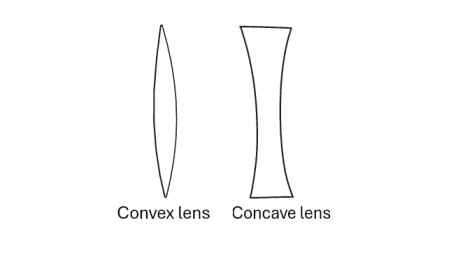
Question. Which one of the following materials cannot be used to make a lens? [NCERT]
(a) Water
(b) Glass
(c) Plastic
(d) Clay
Ans. (d) Clay
Rules For Refraction of Rays by Spherical Lens
1) A ray of light from the object, parallel to the principal axis, after refraction from a convex lens, passes through the focus on the other side of the lens. In the case of a concave lens, the ray appears to diverge from the focus located on the same side of the lens.

2) A ray of light passing through a focus, after refraction from a convex lens, will emerge parallel to the principal axis. A ray of light appearing to meet at the focus of a concave lens, after refraction, will emerge parallel to the principal axis.

3) A ray of light passing through the optical centre of a lens will emerge without any deviation.

Image Formation by Convex Lens
1. When the object is placed at infinity
In this situation convex lens forms the real image at focus which is real, inverted and highly diminished (small).

2. When the object is placed beyond centre of curvature
In this situation convex lens forms the image between centre of curvature and focus which is real, inverted and diminished.
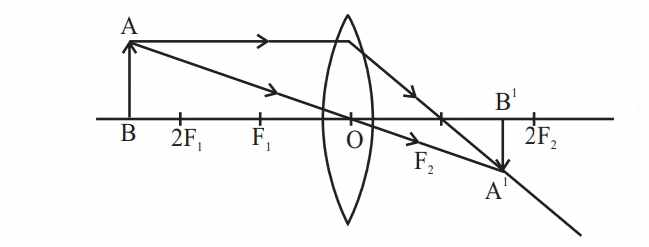
3. When the object is placed at centre of curvature
In this situation convex lens forms the image at the other centre of curvature which is real, inverted, and the same size as the object.
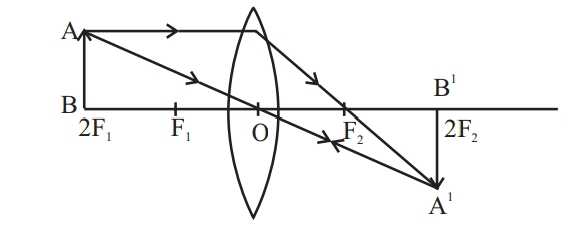
4. When the object is placed between centre of curvature and focus
In this situation, the convex lens forms the real image behind the centre of curvature which is real, inverted, and larger than the object.

5. When the object is placed at focus
In this situation convex lens forms the image at infinity which is real, inverted, and much larger than the object.
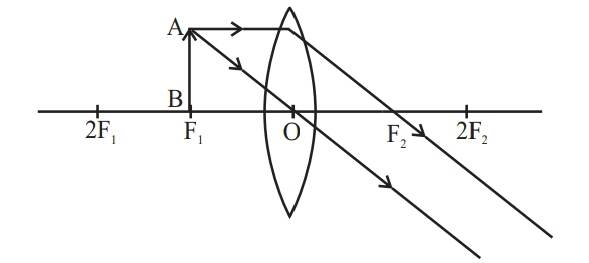
6. When the object is placed between the focus and the optical centre
In this situation convex lens forms the image at the same side of the object which is virtual, erect, and enlarged.
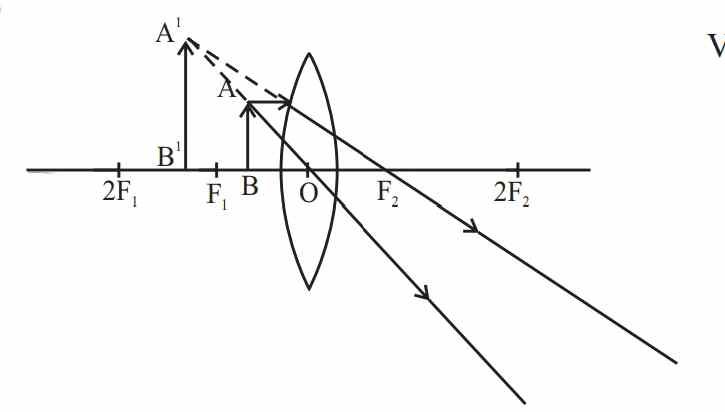
Image Formation by Concave Lens
1. When the object is placed at infinity:
In this situation concave lens forms the image at focus which is virtual, erect, and highly diminished (point-sized).
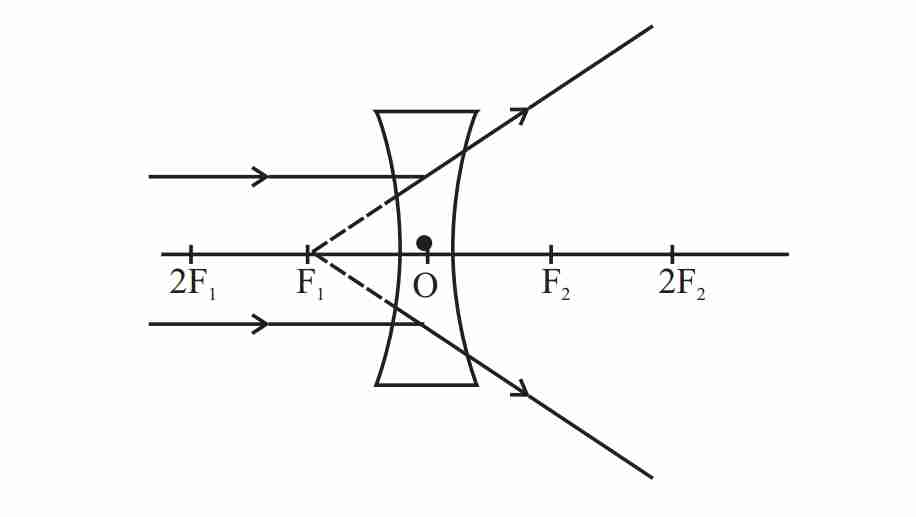
2. When the object is placed between infinity and optical centre:
In this situation concave lens forms the image between focus and optical centre which is virtual, erect, and diminished.
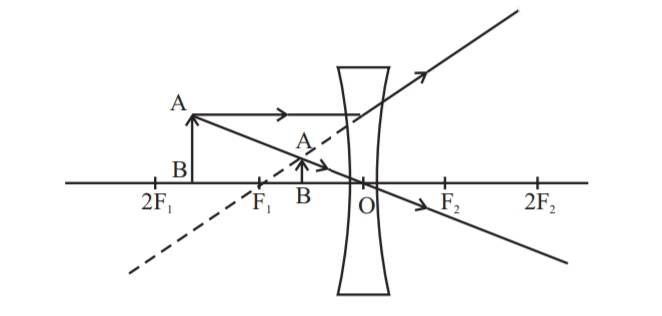
Lens Formula
\frac{1}{f}=\frac{1}{v}-\frac{1}{u}
where,
f= focal length of spherical lens
v= distance of the image from the lens
u= distance of the object from the lens
Magnification
It is the ratio of height of image to the height of object.
m=\frac{h_{i}}{h_{o}}
or
m=\frac{v}{u}
where,
v= distance of the image from the lens
u= distance of the object from the lens
hi= height of the image
ho= height of the object
Power of a Lens
P=\frac{1}{f}
Note: The SI unit of power of a lens is “dioptre” and it is denoted by D.
Note: The power of the convex lens is positive.
Note: The power of the concave lens is negative.
1 Dioptre: 1 Dioptre is the power of a lens whose focal length is 1 metre ( 1D = 1m-1).
Note: If any optical instrument have many lens then the net power will be-
P = P1 + P2 + P3 +……..
Important Questions
Question. A concave lens of focal length 15 cm forms an image 10 cm from the lens. How far is the object placed from the lens? Draw the ray diagram. [NCERT]
Question. An object 5 cm in length is held 25 cm away from a converging lens of focal length 10 cm. Draw the ray diagram and find the position, size and the nature of the image formed. [NCERT]
Question. Find the focal length of a lens of power – 2.0 D. What type of lens is this? [NCERT]
Question. Find the power of a concave lens of focal length 2 m.
Question. A thin lens has a focal length of –25 cm. What is the power of the lens and what is its nature?
Question. Two thin lenses of power +3.5 D and –2.5 D are placed in contact. Find the power and focal length of the lens combination.
Question. A doctor has prescribed a corrective lens of power +1.5 D. Find the focal length of the lens. Is the prescribed lens diverging or converging? [NCERT]
Question. An object is placed at a distance of 50 cm from a concave lens of focal length 30 cm. Find the nature and position of the image.
Question. A student has three convex lenses A, B and C of different focal lengths. He wants to observe the images formed by these lenses on a screen by placing a candle flame at different distances as given in following table: [2024]
| Case No. | Lens | Focal Length | Object Distance |
| 1 | A | 50 cm | 25 cm |
| 2 | B | 20 cm | 60 cm |
| 3 | C | 15 cm | 30 cm |
(i) List two properties of the image formed by the lens B in case no. 2.
(ii) In which one of the three cases given above will the lens form a real image of the same size as the object and why?
Question. The variation of image distance (v) with object distance (u) for a convex lens is given in the following observation table. Analyse it and answer the questions that follow : [2024]
| S. No. | Object Distance (u) cm | Image Distance (v) cm |
| 1 | – 150 | + 30 |
| 2 | – 75 | + 37.5 |
| 3 | – 50 | + 50 |
| 4 | – 37.5 | + 75 |
| 5 | – 30 | + 150 |
| 6 | – 15 | + 37.5 |
(i) Without calculation, find the focal length of the convex lens. Justify your answer.
(ii) Which observation is not correct? Why? Draw ray diagram to find the position of the image formed for this position of the object
(iii) Find the approximate value of magnification for u = – 30 cm.
Question. The focal length of a concave lens is 20 cm. At what distance from the lens should a 5 cm tall object be placed so that its image is formed at a distance of 15 cm from the lens? Also calculate the size of the image formed. [2024]
Question. An object is placed at a distance of 30 cm from the optical centre of a concave lens of focal length 15 cm. Use lens formula to determine the distance of the image from the optical centre of the lens. [2024]
Question. For an object, a convex mirror always forms an image which is : [2024]
(A) Virtual, erect and magnified
(B) Virtual, erect and diminished
(C) Virtual, inverted and diminished
(D) Real, erect and diminished
Assignment I : Reflection and Refraction
Question. What is mirror formula?
Question. Define reflection of light and also explain law of reflection of light.
Question. Explain concave and convex mirror also explain principal focus and focal length for both with suitable diagram?
Question. Explain four rules for tracing images formed by concave mirrors and two rules for convex mirror with suitable diagram.
Question. Draw the images which is formed by a concave and convex mirror in different positions of the object.
Question. An object 4 cm in size is placed at a distance of 25 cm from a concave mirror of focal length 15 cm. Find the position, nature and height of the image.
Question. A 4.5 cm needle is placed 12 cm away from a convex mirror of focal length 20 cm. Give the location of the image and magnification. Describe what happens as the needle is moved farther from the mirror.
Assignment II : Reflection and Refraction
Question 1. Define the refraction of light with suitable diagram.
Question 2. Explain absolute refractive index and relative refractive index, also explain their formula.
Question 3. Describe the laws of refraction of light?
Question 4. With the help of diagram, explain the direction of bending of light?
Question 5. Explain the refraction through a rectangular glass slab.
Question 6. Explain principal focus and focal length of a convex lens.
Question 7. Explain the formation of images by a convex lens.
Question 8. Define power of lens.
Question 9. A concave lens has focal length of 15 cm, at what distance should an object from the lens be placed so that it formed an image at 10 cm from the lens. Also find the magnification of the lens.
Question 10. A convex lens of focal length 20 cm is placed in contact with a concave lens of focal length 10 cm. What is the focal length and power of the combination.
We hope that provided Class 10 Science Notes, “Light: Reflection and Refraction,” will be helpful to you. If you have any queries regarding the Class 10 Science Notes, please drop a comment below, and we will get back to you as soon as possible.
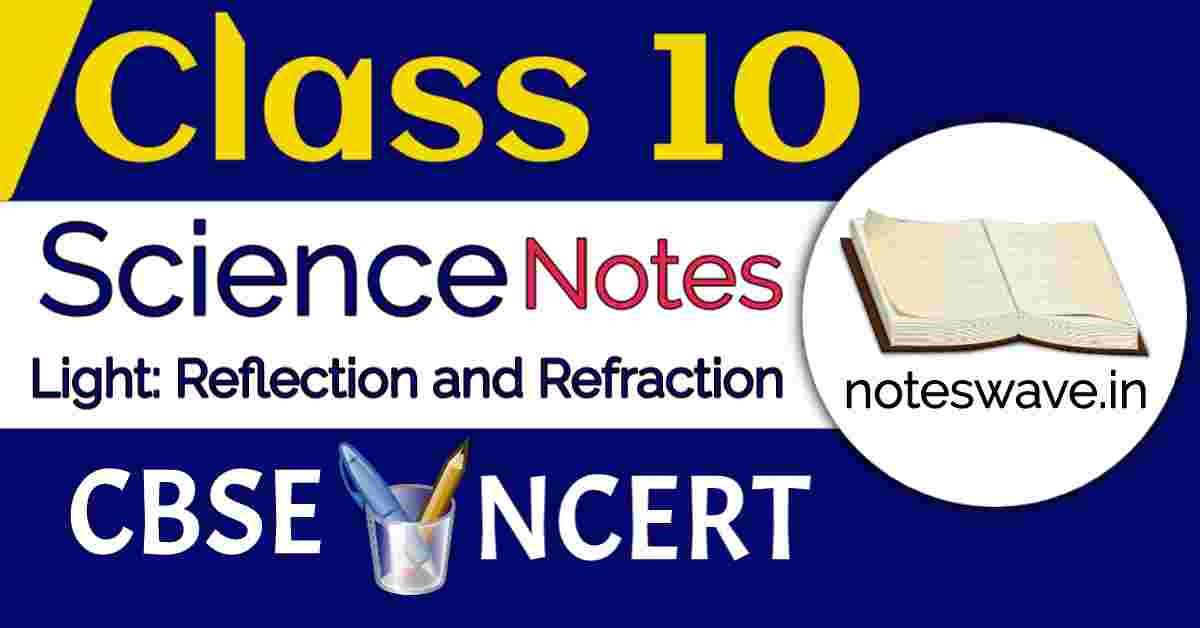
Very wonderful notes
Thanks
This notes is very useful for my board exam. I am so glad by your help for my bright future
Thank you so much sir
Keep growing
Thanks Zaid ♥️
This notes is excellent.
It help the student for scoring good marks in board exam
Thanks
The notes are easy to understand and it helped me to solve numericals , assignment and PYQ’s
Thanks
Thanks
Nice notes sir
Thanks
Such a nice experience
Your notes, Your’s questions, Your’s PYQ’s
Concept
It really helps in my studies..
I really appreciate your hard work…
“Thank you so much! Your support truly motivates me to keep sharing more helpful content 😊.”
This is vetry short and precise notes and it is very helpful.
Thank you Anubhav ♥️